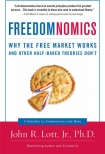Freedomnomics: Why the Free Market Works and Other Half-Baked Theories Don't John Jr. (the dot read aloud .txt) 📖

- Author: John Jr.
Book online «Freedomnomics: Why the Free Market Works and Other Half-Baked Theories Don't John Jr. (the dot read aloud .txt) 📖». Author John Jr.
33 It should be noted that predation is not a factor in the phenomenon of large chains like Wal-Mart, Target, or Home Depot driving small mom-and-pop stores out of business. The success of these companies in eliminating smaller competitors stems from their huge selection and especially their low costs, which enable them to charge lower prices than small, independent stores. These low prices are permanent; the chains do not lower prices to drive out competitors, and then subsequently raise them once they no longer face competition. Therefore, these are not examples of predation.
34 Ibid., Chapter 1. See also Robert H. Bork, The Anti-trust Paradox: A Policy at War with Itself, (New York: The Free Press, 1978) 39-40.
35 Matthew Josephson, The Robber Barons (New York: Harcourt, Brace, 1934), 205. For a longer discussion of this and other examples, see my book, Are Predatory Commitments Credible?: Who Should the Courts Believe?, (Chicago: University of Chicago Press) 1999.
36 The predator must be a publicly trade firm for this tactic to be successful. Additionally, the maneuver is most successful when the predator is a non-diversified company.
37 Levitt and Dubner, Freakonomics (2005 ed.), 67.
38 The Lemons argument has actually been around for decades, though the person who first brought up the concern realized that there could be strong forces to solve the problem. See George Ackerlof, “The Market of Lemons,” Quarterly Journal of Economics, August, 1970, 488-500. There are other papers that have found evidence that the market solves this lemons problem (Eric W. Bond, “A Direct Test of the ‘Lemons’ Model: The Market for Used Pickup Trucks,” AER, 72(4), September 1982, 836-840, and Wimmer and Chezum, “An Empirical Examination of Quality Certification in a ‘Lemons Market,’” Economic Inquiry, 41(2), April 2003, 279-91).
39 Http://www.carsense.com/about.asp.
40 The study was conducted on September 27, 2006.
41 http://www.kbb.com/kbb/CompanyInfo/FAQ.aspx#nc_1.
42 This assumes that the car is in “excellent” condition.
43 Steven Levitt and Chad Syverson, “Market Distortions when Agents are Better Informed: The Value of Information in Real Estate Transactions,” University of Chicago working paper, January 2005.
44 Stephen Dubner, “The Probability That a Real-Estate Agent Is Cheating You (and Other Riddles of Modern Life),” New York Times, August 3, 2003.
45 Levitt and Dubner, Freakonomics, revised edition, 49, 64. The authors claim that “The fear created by commercial experts may not quite rival the fear created by terrorists like the Ku Klux Klan, but the principle is the same.” The chapter is entitled, “How is the Ku Klux Klan like a group of Real-Estate Agents?”
46 Levitt and Dubner, revised edition, 66.
47 The amount of the difference cited by Levitt has changed over time. The original paper by Levitt and Syverson (“Market Distortions when Agents are Better Informed: The Value of Information in Real Estate Transactions”) put the difference at 3.7 percent, but in Freakonomics Levitt and Dubner quoted it at 3 percent, and the book’s revised edition pegged it at 2 percent.
48 There were a few very important measures that were missing from Levitt and Syverson’s estimates. For example, their empirical work and discussion looks at only the final sale price that property receives and ignores the impact that being an expert has on the original purchase price. Additionally, they did not have a measure of square footage for the house. If realtors happen to own slightly larger houses, this alone could explain the difference in prices. It might also explain the length of time on the market, because their results indicate that larger houses in terms of more bedrooms, other rooms, and bathrooms tend to be on the market longer.
49 Melody Jameson, “Changes in Real Estate Arena Prompt Focused Approaches,” The Observer News (Florida), November 9, 2006.
50 Ian Ayres and Steven Levitt write that “The car owner who installs LoJack internalizes only 10 percent of the total social benefit, however, implying that LoJack will be undersupplied by the free market.”See “Measuring Positive Externalities from Unobservable Victim Precautions: An Empirical Analysis of LoJack,” Quarterly Journal of Economics, February 1998, 43-77.
51 Unfortunately, Ayres and Levitt were unable to provide to others their primary data on the number of LoJack devices installed in cars. An attempt to test whether there was a drop in auto thefts did not confirm these original claims. John R. Lott, Jr., “Does a Helping Hand Put Others at Risk?: Affirmative Action, Police Departments, and Crime,” Economic Inquiry, April 2000, 257.
52 A check with State Farm, Allstate, and GEICO insurance indicates that this pattern is still true as of November 2006. For example, here are some statistics by state for Allstate, the nation’s second largest auto insurance company—Connecticut: no state mandate, no Allstate discount for LoJack (Carol A. Sarabia, Associate Examiner, Connecticut Insurance Department); Florida: state mandated discount of 10 percent, Allstate discount of 10 percent (Valerie, Consumer Service Agent, Florida Office of Insurance Regulations, 11/6/06); New York: state mandated discount of 15 percent, Allstate discount of 15 percent (Car Alarms and Car Insurance in New York, Transportation Alternatives. Campaign Memo. April 28, 2004); New Jersey: state mandated discount of 20 percent, Allstate discount of 20 percent (New Jersey Administrative Code, 11:3-39, obtained via Michie’s Legal Resources, http://www.michie.lexisnexis.com/newjersey); Pennsylvania: state mandated discount of 10 percent, Allstate discount of 10 percent (Chuck Romberger, Director, Property and Casualty Bureau, Pennsylvania Insurance Department); and Oregon: no state mandated discount, no Allstate discount (Greg Ledbetter, Senior Consumer Advocate, Oregon State Insurance). This pattern is also true for State Farm Mutual and Progressive Casualty Groups. State Farm, Allstate, and Progressive were the three largest insurance companies in 2005. (http://www.iii.org/media/facts/statsbyissue/auto/).
The quote is from Ian Ayres and Barry Nalebuff, “Stop, Thief!” Forbes, January 10,





Comments (0)